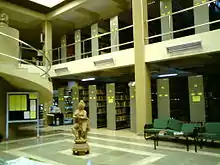Institute of Physics, Bhubaneswar
Institute of Physics, Bhubaneswar (Odia: ପଦାର୍ଥ ବିଜ୍ଞାନ ଅନୁଷ୍ଠାନ) is an autonomous research institution of the Department of Atomic Energy (DAE), Government of India.[2] The Institute was founded by Professor Bidhu Bhusan Das, who was Director of Public Instruction, Odisha, at that time. Das set up the institute in 1972, supported by the Government of Odisha under the patronage of Odisha's education minister Banamali Patnaik, and chose Dr. Trilochan Pradhan as its first director, when the Institute started theoretical research programs in the various branches of physics.[2] Other notable physicists in the Institute's early days included Prof. T. P. Das, of SUNY, Albany, New York, USA and Prof. Jagdish Mohanty of the Indian Institute of Technology, IIT Kanpur and Australian National University, Canberra. In 1981, the Institute moved to its present campus near Chandrasekharpur, Bhubaneswar. It was taken over by the Department of Atomic Energy, India on 25 March 1985 and started functioning as an autonomous body.[3]
 | |
| Type | Research Institution |
|---|---|
| Established | 1972 |
| Founder | Bidhu Bhusan Das |
| Affiliation | Homi Bhabha National Institute, Department of Atomic Energy |
| Director | Dr. S.M.Yusuf[1] |
| Location | , , |
| Campus | Urban |
| Acronym | IOP, Bhubaneswar |
| Website | www |
Research

The institute conducts research in theoretical and experimental physics.
Theoretical physics
Research areas in theoretical physics include condensed matter theory, nuclear and high energy physics. High-energy theorists at IOP have made contributions to field theories, phase transitions in early universe, cosmology, the Planck scale phenomena, string theory and high-energy nuclear physics such as qgp, equation of state and nuclear astrophysics, neutron stars, high-energy phenomenology and neutrino physics phenomenology.[2] In theoretical condensed matter physics, research is centered on disordered systems, magnetism, superconductivity, low-dimensional systems, statistical physics, strongly correlated systems, phase transitions, clusters and nanomaterials.[2]
Experimental physics

The experimental physics group encompasses accelerator-based research for advanced chemical and radioisotope analysis. The ion beam laboratory (IBL) is equipped with a 3MV tandem accelerator (NEC 9SDH-2).[4] Research at the IBL includes Rutherford back scattering, Particle-induced X-ray emission, accelerator mass spectrometry, channeling, ion implantation, surface modification and characterization, microbeam analysis and nuclear reaction studies.
The 3 million volt NEC 9SDH-2 pelletron accelerator of the Accelerator Mass Spectrometry lab is a multi-disciplinary research accelerator for various physics experiments.[5] The experimental facilities available in the ion beam laboratory include an accelerator mass spectrometry (AMS) for radiocarbon dating, micro-beam facility and an external beam facility.[5] Other experimental facilities include an ESCA (electron spectroscopy for chemical analysis), HRTEM (high resolution transmission electron microscope), MBE (molecular beam epitaxy), cluster generator and nano material research facility.
Education
The Institute runs regular pre-doctoral (Master of Philosophy) and doctoral (PhD.) programs for postgraduate students of physics. The course work is planned to emphasize doctoral research and teaching skills.[6]
References
- https://www.iopb.res.in/director2020
- Dr. R. K. Chaudhary. "Institute of Physics: A Profile". Archived from the original on 27 September 2008. Retrieved 25 October 2009.
- "Overview". Retrieved 25 October 2009.
- "Experimental Facilities, Institute of Physics, Bhubaneswar". Retrieved 25 October 2009.
- "AMS Homepage". Archived from the original on 30 May 2008. Retrieved 25 October 2009.
- "Institute of Physics, Bhubaneswar - PhD. Admissions". Retrieved 25 October 2009.